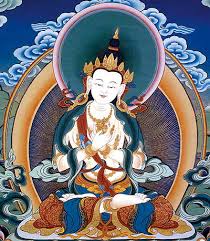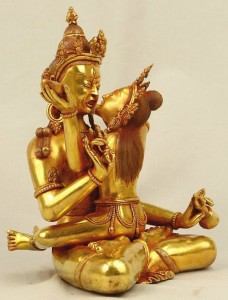Vila Verde, Portugal
A number of years ago while teaching on the 9th Karmapa Wangchuk Dorje’s shorter mahamudra text named ‘Pointing Out the Dharmakaya’, Ringu Tulku sowed the seeds for this year’s summer-camp topic, when he introduced the idea of group practice for accumulating merit. He explained that one hundred people reciting the Vajrasattva mantra in unison, or at least together in one place and as part of a shared practice session, the number of mantras recited would be multiplied for the benefit of each person in the room, according to how many are reciting. One mala of mantras recited by each person would count for 10,000 if we recited together as a group of one hundred.
Vajrasattva
In 2007, I had attended the annual Monlam teachings when His Holiness Karmapa had introduced a ‘Brief Preliminary Practice’ (Ngöndro ), and had received the transmission given especially for the use of Westerners who have ‘such busy lives and so little time’. It was the first time that His Holiness had ventured to speak in English to such a large gathering; he had expressed his nervousness at the task, and his delight at the ‘easy bit’ – the Vajrasattva Mantra. This brief practice, he said, could be recited by Westerners in English, and each section was to be repeated only 10,000 times.
And so it happened: under the tutelage of Ringu Tulku, this year, we experimented, in a Christian monastery in the north of Portugal, to see if one complete Ngöndro might be completed by 150 people during 6 days of group practice. The concession of a brief text, in English, combined with help from 150 other people seemed like a very suitable arrangement, but with one adjustment. Between us we were to complete a full 100,000 repetitions of each practice: contemplating the Four Thoughts and raising Bodhicitta, reciting the Refuge Prayer and doing Prostrations, practising Vajrasattva, making Mandala Offerings, and practising Guru Yoga. For those of us with creaky bodies who had a hard time prostrating, these could be bartered for Mantras or Mandala Offerings, as no one was counting who did what as long as it was accomplished. It was a foolproof and authentic sangha support system!
Rinpoche has suggested that by approaching ngondro later on the Path, we are better prepared to benefit from doing so, because a novice practitioner often misses the point and becomes preoccupied with achieving the target numbers, a common mistake which can be a hindrance to furthering one’s understanding. Ngöndro is a means to purify karma- misguided or negative action – and in particular, prostrations engage with the natural tendency towards pride, often the least obvious klesha or obstacle to realisation, and the last one to fully purify on the path.
Ringu Tulku taught twice each day, morning and afternoon, giving instructions before practice sessions. To encourage us he first he told the story of Patrul Rinpoche’s student who developed the ability for astral travel while in ngondro retreat. It is said that Patrul Rinpoche’s own practice was Ngöndro , and he prostrated 100 times everyday for the whole of his life. There are, according to Ringu Tulku, several ways to become a Buddha: by ripening your own qualities you will grow into buddhahood, but will not be recognised by others. Sakyamuni also taught that once a person develops their qualities they must continue and create a buddhafield wherein many more beings can benefit, and that will identify him or her as a Buddha. It is said that a person who practises the preliminaries will never be born into a lower realm, and the action of the week of practising together in this way would also create a permanent and positive link between us all.
Portugal in August is extremely warm, so prostrations were practised before breakfast, and dozens of us lined up along the cool corridors, (or, for the really wise with toughened knees, on cold marble floors that had the extra bonus of a polished surface).
It feels somewhat counter-productive and hard to justify, totting up repetitions to achieve daily targets, having been told that the quality of practise is primary if we are to fully benefit, and this is the downside of believing we should ‘complete’ a Ngöndro , but in the spirit of the week we set to and applied body and mind to that end. The days were full, and the usual socialising that happens over the retreat became less imperative as we engaged with the practice. The mornings were spent in silence unless questions arose in the teaching sessions, the sun shone outside, the river flowed at the bottom of the hill, the usual pesky mosquitoes took a blessed holiday, perhaps busy with their own Ngöndro . We ate three times a day and we practised, beginning at 7 am and finishing by 8 pm for supper. Each day numbers were handed in. Francois oversaw the counting and the next day’s programme would be adjusted accordingly to ensure full quotas in all fields. There was concern that prostrations might lose out to Guru Yoga, or that we wouldn’t finish the Offering Mandalas, and there was irritation when bare feet walked on hard uncooked saffron rice, or even worse, precious stones.
For the Guru Yoga we avidly recited Karmapa Khyenno, and reached double our quota in two sessions. Rinpoche feels that the wording to the prayer of the four kayas is just not inspiring enough in the way it is translated, and is hoping an aspiring poet will write a version that will do it justice, it seems the current translation is too literal and cumbersome, the Tibetan version is so beautiful.
Rinpoche gave wonderful teachings on Guru yoga, reminding us to remain intelligent and critical, to examine and wait and, if one’s personal teacher is not yet to be found, to consider looking to Vajradhara or Sakyamuni, because they will be the essence of your teacher when that person appears. We may have many teachers, and each will feed into the other, but once the heart teacher is met it will be clear and the relationship and the progress on the path should flourish.
One evening, Rinpoche gave a Vajrasattva empowerment coming from the Nyingma tradition, describing the deity embracing a consort: wisdom and skilful means in primordial union. Giving a narrative alongside the liturgy, he built up the visualisation for us as he relayed the instruction, reminding us all the time that everything that arises through the visualisation is an aspect of our mind, nothing more. His description of the visualisation provided us with an exquisite and uncompromisingly clear understanding of the practice. At the finish, the room was quite silent, full of awe, expectant and wanting, but he just he reminded us he was hungry. It was time for supper.
Nyingma Vajrasattva
The final count for the week was impressive as all recitations were completed and there were plenty left over to make up for miscounts. We also managed to watch a documentary on Gene Smith, watch a gorgeous slide presentation on Rigul, from whence Francois has just returned with much news. Some gathered for stories and songs or walks to the river with Rinpoche, and we absorbed the incredible news that His Holiness Karmapa will visit Germany in three weeks time.
In the interest of future practice, in case anyone thinks they have completed Ngöndro – Ringu Tulku finished by simply saying that now we just know how to do it.
The Summercamp next year will again be at Vila Verde, the first week in August, and will be organised by Lama Tsultrim and the Portugese Sangha, as Tsering Paldron enters retreat.
Annie Dibble is currently co-ordinator for Bodhicharya Ireland, and a Tara Rokpa Therapist. In another life she recently retired from teaching 3rd level art and design and is now working to create supportive links between weavers in India, Nepal and Dublin.






Leave a Reply